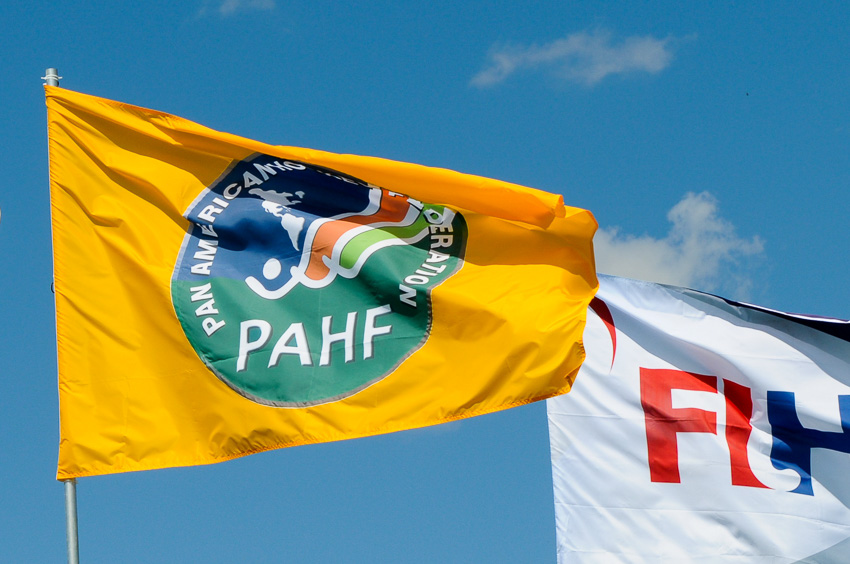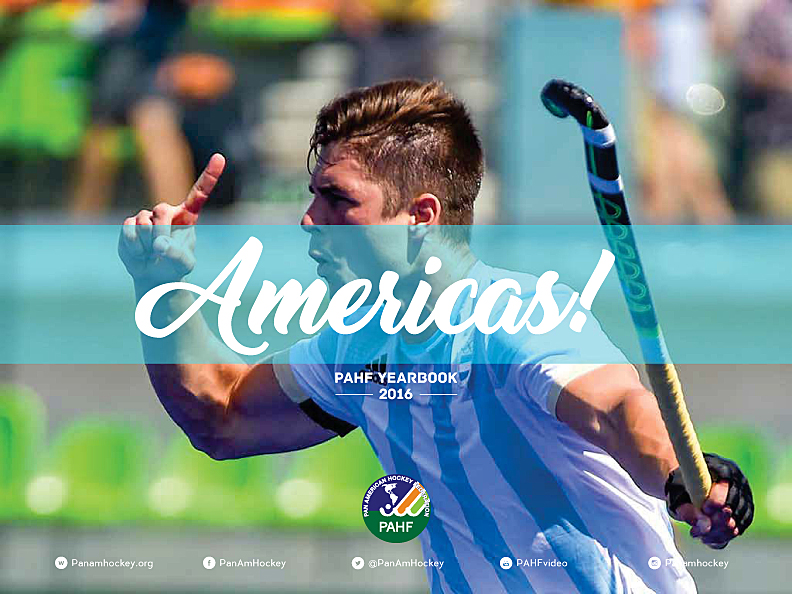
As the year draws to a close, we can reflect upon some of the highlights of the hockey calendar. Of course, that magical night in Rio with Los Leones is the icing on the cake, but as we trawl back through the archives, it is clear that on the whole, PAHF and its individual nations have had a pretty good year of hockey.
Let’s take a look back over the past 12 months:
In February, the Asociacion Deportiva Nacional de Hockey de Guatemala learnt that it had been awarded the International Hockey Federation’s 2015 Pablo Negre Trophy, awarded to national associations for their dedication to promoting hockey and embracing the spirit of the sport. President of the Asociacion Deportiva Nacional de Hockey de Guatemala, Pablo Reyes, said: “The award is fundamental for us because it means we can take our hockey to the next level. Currently there is no hockey pitch in the whole of Central America.
“The pitch (supplied by Polytan STI) will help to develop hockey in Central America. Guatemala will be the principal beneficiary, of course, but we want to share this award with our neighbours.”
Looking back on the past few years, the president admitted it had sometimes been a slog: “We had the full support of the Guatemalan Olympic Committee and the PAHF when we started our journey 10 years ago but you have to bear in mind that, in the first five years, there weren't many balls and sticks – in fact no-one sells them in Guatemala – few places to play, few teams to play. To keep the interest of the people was not easy.”
April saw the Junior Pan American competitions burst into action, First was the women’s event, held in Tacarigua. The final was a resumption of rivalries between USA and Argentina and this time, just as in the 2012 edition, it was the south Americans who came away with the honours. They beat USA 6-0, while Chile took third place after an impressive 3-0 win over Canada.
The men’s competition, held in Toronto saw Argentina complete yet another clean sweep of the competition as they beat Canada by a 5-0 scoreline. This was their 11th consecutive defence of the title. Chile took bronze when they beat USA 4-1.
Also performing well at the Junior Pan-Am Championships was 23-year-old Tyler Klenk, who took his first steps into the international umpiring arena when he took charge of the pool match between Argentina and Trinidad and Tobago. The Canadian said he was grateful that his first international appointment had been on home soil. Later in the tournament, Klenk umpired the bronze medal match between Chile and the USA.
July saw Argentina and USA women head over to England for the Champions Trophy. This was the last major international before Rio 2016, so both teams were keen to make an impression. And boy did both teams deliver! First, the USA put some unconvincing performances in the pool stages behind them to take the bronze medal in a display of defiant strength and courage against the world number three side Australia; and then Argentina wowed the crowds and the opposition – the Netherlands – with a virtuoso performance to take their seventh title.
The matches panned out very differently. For USA, it was a case of showing its now legendary ability to relentlessly work and turn things around, after the Hockeyroos took a 2-0 lead. Katie Bam hit back with a double and then Jackie Briggs reinforced her reputation as a great ‘keeper with a string of saves in the shoot-out. That performance is one of the many reason, Briggs is nominated for the 2016 FIH Goalkeeper of the Year award.
In the final, Argentina defended their title as they took a 2-0 lead against the world’s number one side the Netherlands which, although the Dutch clawed one goal back, the reigning champions never looked like conceding. Speaking after the final, captain of Las Leonas, Carla Rebecchi, who is nominated for the FIH 2016 Player of the Year, said : “Today was very different to yesterday [when Argentina lost to Netherlands in the pool match] there is something inside us that make us play better in finals. We know that when we get on the pitch in the final we have to give a little bit more than in other matches. We have to celebrate this victory.”
The highlight of the year was, of course, the Olympic Games on our own continental soil. It wasn’t just the fact that Argentina men made history by winning their first gold medal – in a thrilling 4-2 win over Belgium – it was the whole spectacle. From the blue, yellow and green pitch, which was so vivid on our screens, to the carnival atmosphere in the stadium, to the millions of fans around the world glued to their televisions, computers and smart-phones, this was hockey at its very best. Big, bold, loud and watched by millions both in the stadium and at home, this was hockey South American style.
And then there was Carlos. Nominated for FIH Coach of the Year award, Carlos Retegui proved just what a talented coach and manager of players he is. Speaking after the final, a barely coherent ‘Chapa” said: “I'm super proud of the guys, players who are a machine. They have blood in their hearts, we have heart and now we have entered the history books. The differences between winning and losing are minimal, a second, a fraction. It is a prize for which we work, work and work some more. This is a dream come true.”
Both Gonzalo Peillat and Lucas Vila are nominated for FIH Player of the Year awards, which will be announced in January.
From the huge, multi-event in Rio, hockey’s next Pan American event moved to Salamanca in Mexico, where four men’s teams and three women’s teams competed in one of the Hockey World League Round One events. Mexico women and USA men triumphed and will both be contesting the HWL Round Two events in Vancouver and Tacarigua respectively. Barbados men will also be joining the party as they were runners-up to USA.
In Chiclayo, Peru, the South American Championships doubled up as a HWL Round One. Whoever won the event would not just lift the South American Championship trophy but would also qualify for HWL Round Two and a chance to qualify for the 2018 World Cup via the HWL process. In the women’s competition it was the top two seeds who finished in first and second place and both teams will be competing in Vancouver, Canada in April 2017. Uruguay lifted the trophy after a 1-0 win over Chile, their higher ranked rivals. Chile men made it a double when then beat Paraguay in the penalty shoot-out. The result means the new South American Champions will compete in HWL Round Two in Tacarigua, Trinidad and Tobago in March 2017.
In October, the Central America Indoor Tournament saw Guatemala men and Panama women resume their winning ways as both teams successfully defended the titles they have won for the past three editions. Guatemala saw off the challenge from Costa Rica, while the Guatemala women put Panama under huge pressure in the women’s final.
The men’s and women’s Junior World Cup competitions, held in Santiago and Lucknow respectively, were a showcase for the future of hockey. For Argentina U21 women and their coach Agustin Corradini, this was the perfect end to a campaign that had begun a year before the Pan Am Junior Championships.
“I feel very proud. The players showed a very dynamic, collective and focused way of playing hockey and were also very kind and respectful off the field,” said the coach as he reflected on the event.
“For me the quarter finals were the most nerve-wracking time. If they had lost at that stage, we would not have been able to show the magnificent progress this team has made in two years.”
Corradini need not have worried. His team won the quarter-finals and the semi-finals and then “played without fear” against the top-ranked Dutch to take the title. “We were very intense when we were defending, and very dynamic in the attack,” said the 32-year-old coach, “we played with aggression with the ball and did not let emotion get in the way of the thought processes.”
Argentina’s rivals in the quarter finals were another Pan Am team, USA. Head coach Janneke Schopman, who has been nominated for FIH Women’s Coach of the Year, gave her reflections on the tournament: “The Junior World Cup has been a great experience for our team. The level of the tournament, especially playing teams like Holland and Argentina showed our players what the highest level in youth hockey is and what is needed for the next step. We have shown a lot of growth since the Junior Pan Ams and were able to play more competitively against these high calibre teams. Similarly playing different countries with different playing styles like an Asian country (Korea), gave the team much needed exposure and familiarity with different hockey styles. With the limited preparation time we had in comparison I think we performed well and gained the necessary experience for the potential next step to the national team for these junior players.”
Danae Andrada, newly elected to the FIH Executive Board, praised the Chile Hockey Association for its organisation of the Women’s Junior World Cup. “Chile has made a great commitment to organize a World Cup on South American soil. The outcome was a world level hockey party which demonstrated the level of excellence at which our junior teams are performing. The techniques, power, speed, tactical systems and professionalism which were showcased in Santiago show us a very promising future for our sport. Officials, referees, leaders, coaches and the general public have been able to be stars in a tournament that was broadcast to the whole world and that encourages us to continue perfecting ourselves in our roles within the sport.”
And so to Lucknow, where Argentina and Canada were flying the flag for PAHF at the Men’s Junior World Cup. Unfortunately this was not to be either team’s moment in the sun. Argentina finished fifth, with Canada in 16th position. Argentina will consider themselves unlucky in the quarter-finals when they lost on shoot-out to eventual silver medalists, Belgium, but an earlier draw with Austria and losses to India and Australia in the pool games, indicated that this would not be their year. For Canada, this was a baptism of fire as the young team finished the tournament with no wins recorded. Forward Amrit Sidhu put the results into perspective: “As the youngest team in the tournament it’s been a big learning curve. The pace of the games and the quality of teams is something we don’t see very often in Canada.”
What is so clear from this round-up of events, is the speed with which hockey is developing across the PAHF region. While the hockey super powers of Argentina, USA and Canada continue to perform at the top level, it is teams such as Chile, Uruguay and Mexico that are providing waves of excitement on the international stage.
The future of hockey as a global sport lies in attracting more nations into the hockey family and a myriad of events for all levels of player – such as the Diamond Mineral Water Indoor Hockey Festival in Guyana, which has just come to its exciting conclusion – is evidence that the sport in Pan-America is very much on an upward curve.

